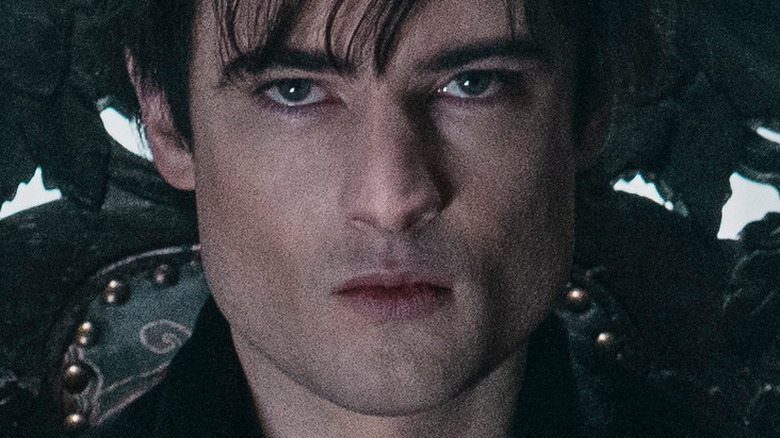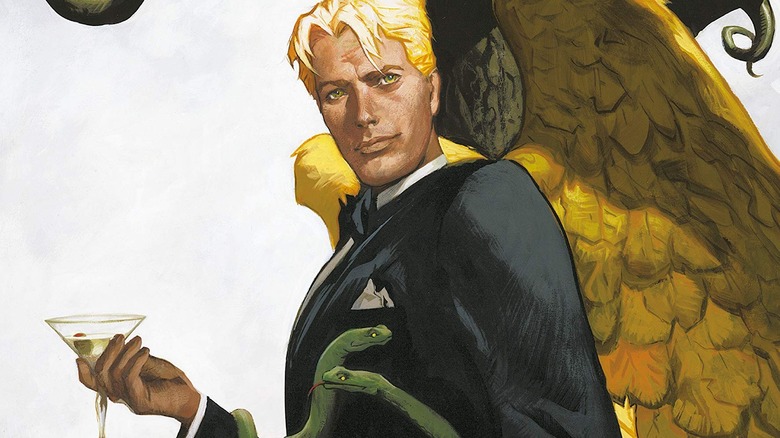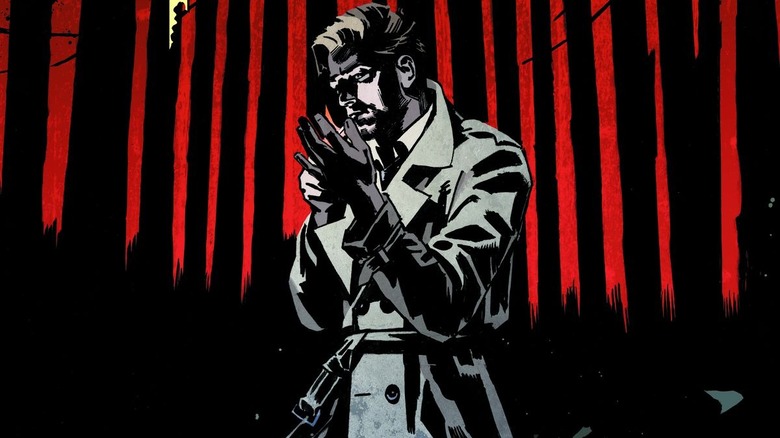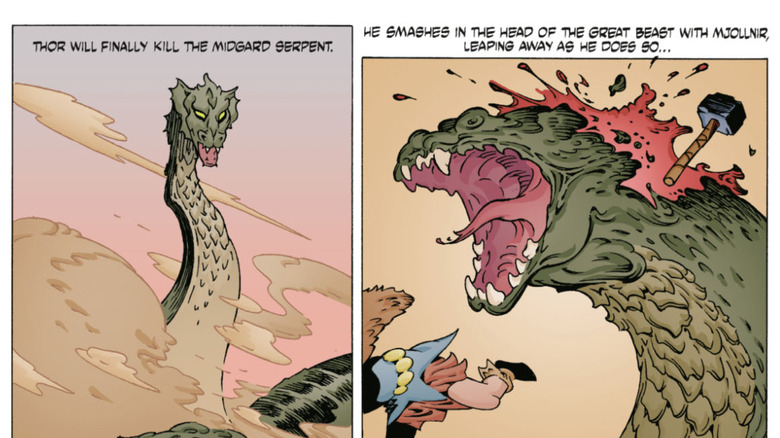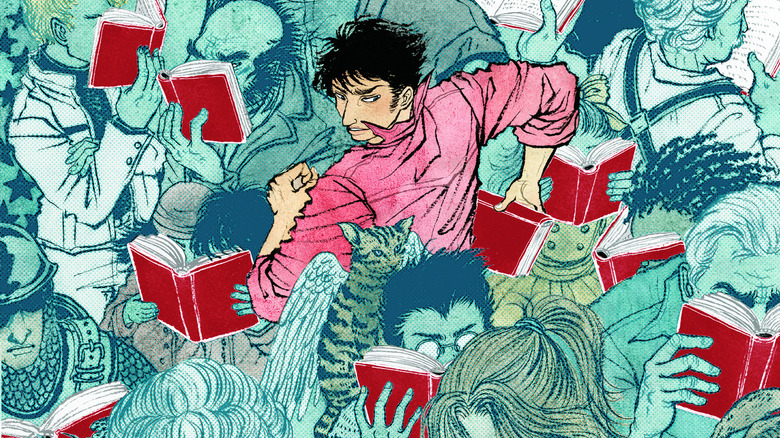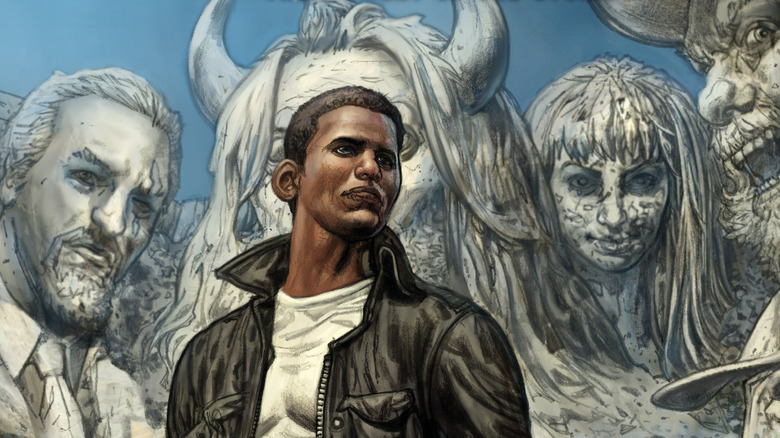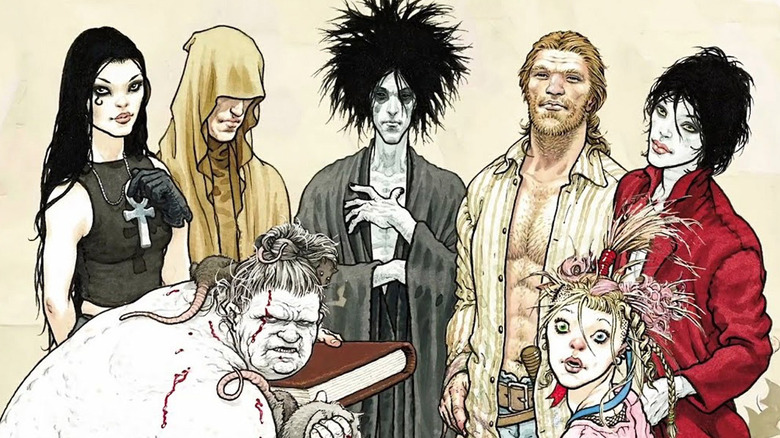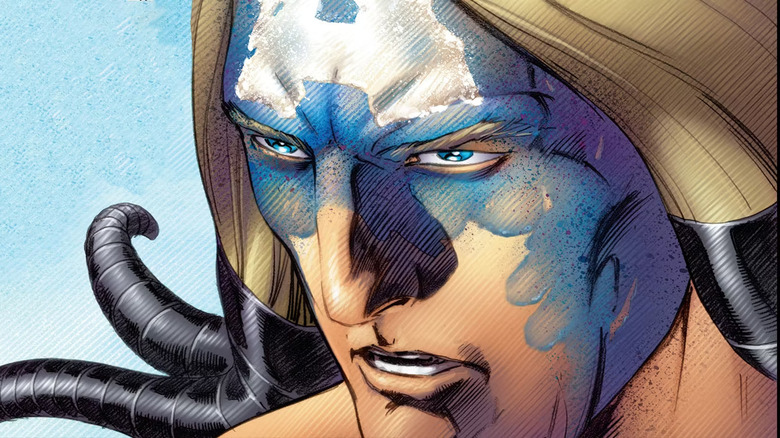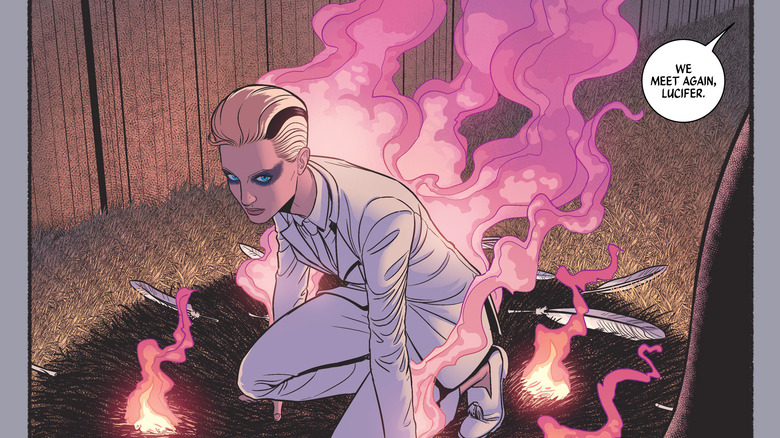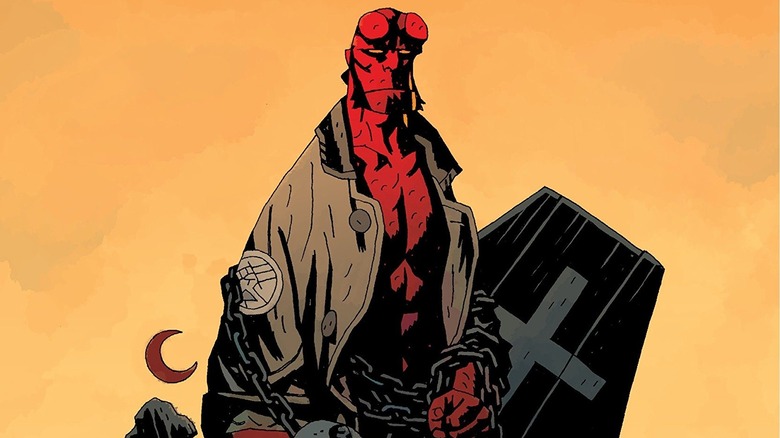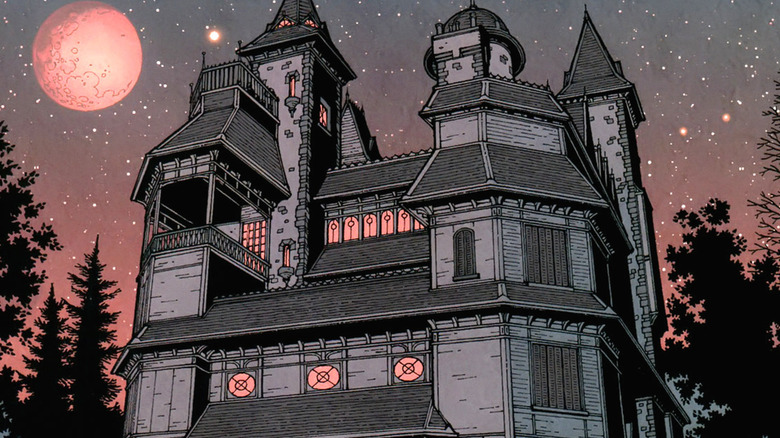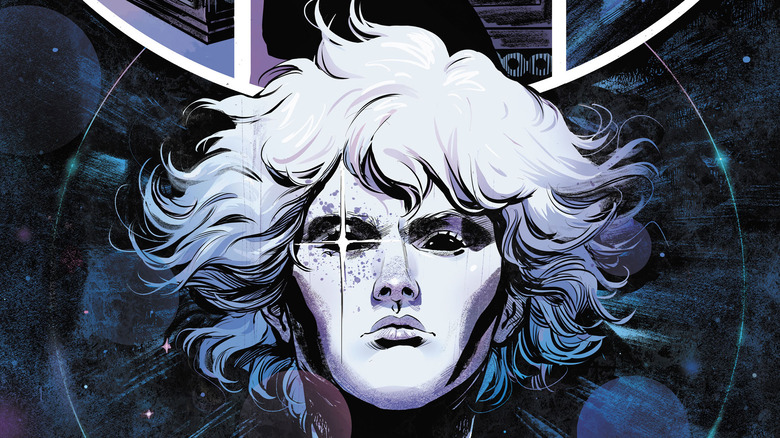Comics To Read If You Love Netflix's The Sandman
It took decades for Neil Gaiman's seminal epic "The Sandman" to make the leap from the comic book page to the television screen, and luckily, fans weren't disappointed. Though not exactly perfect, Netflix's adaptation of "The Sandman" makes up for its flaws with more than enough to please longtime diehards and new viewers alike. The series expertly adapts its source comics, whose intricacy and grandeur have often caused them to be referred to as "unfilmable" throughout the years.
It's no secret that Gaiman's original comic series is a legendary piece of literature and a landmark in the graphic novel industry — as its Hugo, World Fantasy, Bram Stoker, and dozens of Eisner Awards will attest. But "The Sandman" also sits among a truly impressive assortment of comic book peers, whether they're spinoffs, sequels authored by Gaiman, or just spiritual partners.
For anyone who enjoyed Netflix's version of Dream, the Endless, and their labyrinthine interventions into the worlds of mortals and gods, there are more comics for you than solely "The Sandman." If you've finished binging Season 1 and want to scratch that mythical, horrific, poetic itch, here are the comics you should read if you love Netflix's "The Sandman."
Lucifer
Just like the first volume of "The Sandman," we're featuring a fateful trip to Hell. In this case, it's the very same Hell featured in "The Sandman" — one that's every bit as tumultuous and also populated by the same cast of dramatic, godly beings. This trip to Hell comes courtesy of "Lucifer," the "Sandman" spinoff series that shifts its focus from Dream and his cosmic, aloof siblings and onto the titular fallen angel and the various earthbound evils with which he's associated.
This Lucifer is technically the same version as the one featured in the Fox (and then Netflix) series, but aside from their identical origin, the two versions of the Morningstar could not be any more different. The incarnation who stars in the "Lucifer" comic is written by the exceedingly intellectual and poetic Mike Carey, and because of that, this devil is a complex, Miltonian character whose immortal existence is as much of a curse as it is a blessing.
The "Lucifer" series does more than develop the former King of Hell (who decides to shut the place down and head to Los Angeles). It also tells deep, nuanced, and ironically human tales of the (also ironically) demonized figure Lilith, archangels like Michael, and even — spoiler alert — the eventual successor to Yahweh, the demi-Angel Elaine Belloc.
Constantine/Hellblazer
For a lot of lifelong, hardcore comic fans, if they had to cite one single comic series as a survey course of the genre's best writing and art, it would be "Hellblazer," better known in recent decades as the series that stars John Constantine. And yes, Constantine was featured in his own movie of the same name and has also appeared in several DC television series, but none of them manage to capture the level of mythological acumen and moral intricacy that is the original Constantine character.
If you love Netflix's "The Sandman” series, then you saw its version of Constantine, Johanna Constantine. And while actor Jenna Coleman did an admirable job in her role, her newly adapted Constantine isn't 100% reflective of the character from which her role is born. The Constantine featured in the exceptionally long-running and critically-adored "Hellblazer" series is a maze of traits. He's one of the first openly bisexual (and beyond) characters in comics, he's as likely to play the villain as he is the hero or antihero, and his magical adventures draw from Christianity as much as they do Hinduism, geomancy, Vedicism, Kabbalah, and other -ism or -mancy you can imagine.
For a quick and easy introduction to the character and his unique brand of misadventure, check out Simon Spurrier's "John Constantine: Hellblazer" series — only 12 issues and as fine a Constantine story as you could hope to find.
Neil Gaiman's Norse Mythology
You can likely guess from the title of "Neil Gaiman's Norse Mythology" that Gaiman himself wrote the comic. But there's more to the saga of the comic's inception, and it only adds to its richness.
The origins of Norse mythology, like the origins of any mythology, come from multiple sources of varying credibility and translatability. There's no definitive version of Norse myths, only versions that seem by consensus to be the most accurate, most entertaining, or both. Gaiman wisely doesn't attempt to end the evolution of these stories. Instead, he simply adapts them for modern audiences — in as accurate and entertaining a way as possible.
As for the comic series, it's based on Gaiman's book of the same name. The comics present the Norse tales in chronological order, with the addition of rich artistic representation. Gaiman's artists for the comic are a series of legends, including Mike Mignola, iconic writer/artist for "Hellboy." The series is an exceptional read for fans of "The Sandman" for many reasons. For one, it's written by the man behind Morpheus himself. Secondly, it stars multiple "The Sandman" characters like Thor, Odin, and Loki. Plus, it features more of Gaiman's trademark (and paradoxical) poetic prose.
Unwritten
Mike Carey (also known as M.R. Carey) is a literary genius. He's given the world all sorts of terrifying treats, from comics like "Lucifer" to novels like "The Girl with All the Gifts." If you're a fan of those works and are hungry for more Carey, the Vertigo series "The Unwritten" sees the writer at his best. More than just a quality comic story, "The Unwritten" also captures a lot of what makes "The Sandman" so spellbinding: It uses similar meta-narratives, it stars storytellers affecting their world through stories, and it maintains Neil Gaiman's sense of unceasing wonder.
The series begins with an intriguing hook. As a boy, Tom Taylor served as the inspiration for the main character in his father's mega-successful line of children's fantasy stories — essentially, he's the real-world version of Harry Potter or Christopher Robin. But gradually, Taylor begins to discover that his father's stories may not be fantasy at all, and he may not just be the basis for a famous boy-wizard but actually the wizard himself. That's when "The Unwritten" truly begins to scratch some of the biggest itches for fans of "The Sandman" — the series becomes an increasingly layered network of storytellers as characters and stories as reality.
American Gods
If there's one comic series that most closely resembles "The Sandman," it's "American Gods." The story was first published as a novel back in 2001, and in 2017, it was adapted as both a Starz original series and an ongoing comic from Dark Horse. Though all three versions are sure to satisfy anyone who loves "The Sandman," the comic boasts the most parallels with the Morpheus comics.
Like "The Sandman," "American Gods" is written by Neil Gaiman. It also creates a remarkably similar setting — an Earth in which anything that receives enough attention and prayer becomes very real and very powerful. Likewise, those beings of worship who begin to lose followers find themselves weakened and no longer quite so godly. Naturally, in both series, this leads to a conflict between newer, more powerful deities and the older, classical gods who still cling to the last embers of their ebbing religions. Plus, in the "Sandman" comic, Dream and company find themselves contending with characters like Odin and Loki, both of whom play pretty pivotal roles in "American Gods."
Death
From her first appearance way back in 1989's "The Sandman #8," Neil Gaiman's unique take on Death has been met with almost universal acclaim. She regularly features in lists of greatest comic book characters, manages to crossover into mainstream DC comics, and — unlike all the other Endless — was popular enough with readers to earn multiple solo spinoff series. The most notable series, "Death: The High Cost of Living" and "Death: The Time of Your Life," are absolute must-reads for fans of "The Sandman," and they will not disappoint.
Like Netflix's version of the character, so perfectly portrayed by Kirby Howell-Baptiste, Gaiman's original Death most often appears in the form of a beautiful human woman. That, combined with her peppy, childlike sense of joy and playfulness, makes her an exceptionally dualistic character. Though she almost exclusively appears to mortals (and even the Endless themselves) during their single darkest moment, her levity and humor make her sympathetic and even lovable. It's a testament to Gaiman's ability to craft such complex characters that Desire — the Endless who creates love and lust — is less likable than Death, the Endless who ends lives without notice. And because she is everywhere, you can also find Death in her own manga miniseries.
Marvel 1602
Despite being a comic book — and despite its multiple superpowered cameos (such as the villainous John Dee, aka Doctor Destiny) – "The Sandman" shares little in common with mainstream superhero comics. Its sweeping narrative runs through dozens of historical eras, and it spends entire issues debating concepts like the nature of inevitability and change. In other words, it isn't exactly in line with the majority of super tales from the likes of Marvel and DC. However, if that superhero comic is written by Neil Gaiman, you can bet it'll end up closer to the mark, and that is certainly true of "Marvel 1602."
Alongside artist Andy Kubert, Gaiman uses "Marvel 1602" as an opportunity to reinvent many of the company's most beloved heroes, specifically by imagining what they would have become had they all lived during the Elizabethan era. The altered setting allows Gaiman to do what Gaiman does best and insert long tracts of flowery narration and period-accurate dialogue. The book just feels closer to an issue of "The Sandman" than the average Marvel book, and for that alone, it's a comic worth reading for Dream fans.
However, it has another major asset going for it — it is genuinely fun. Many critics have cited how entertaining the whole series is, whether it's Peter Parquagh (the Peter Parker analog) constantly being almost bitten by spiders or the era-appropriate version of Captain America, a Native American (sort of — no spoilers) named Rojhaz (get it?).
The Wicked + The Divine
If you fell in love with "The Sandman" because of all the gods, angels, demons, magic, and mysticism, then there are tons of other series out there to keep you satisfied. Likewise, if what you love about "The Sandman" is its exceptionally diverse portrayal of things like gender and sexuality, then there are a plenty of comics for you. And what if you want a combo of both aspects? Well, undoubtedly, the one comic series that averages the highest score for both is "The Wicked + The Divine."
The series was an Image Comics original that ran for around 50 issues (depending on how you count specials) and followed the Pantheon, a group of teens who become suddenly blessed with godly powers, only then realizing that they are actually reincarnated mythical beings. This event happens every 90 years, and as such, it has come to be known as the Recurrence. The teens that inherit the powers seem at first to be random, as do the mythical beings they become — each recurrence features a different roster of reincarnations, for initially mysterious reasons. The series is expertly written and drawn, and it even boasts one final treat for fans of "The Sandman." It features Lucifer, and like Neil Gaiman's comic book take on the character, this version is also directly based on David Bowie.
Hellboy
Thanks in part to the beloved Guillermo del Toro movies, Hellboy is an ultra-popular character among genre fans. He's even pretty famous among the general population (even if the David Harbour reboot massively bombed). But there are two different Hellboys. There's the movie version — a muscly dope who defeats Nazis and demons alike by punching them, shooting them, and then downing whiskey over their corpses. And then there's the comic book version who, yes, absolutely does every bit of that as well, but he also acts under the direction of series writer and artist Mike Mignola. Thanks to Mignola's craftsmanship, the "Hellboy" comic is a thoroughly researched, deep, even reverent combination of mythologies from cultures across the world and throughout history.
Fans of "The Sandman" will no doubt have noticed the breadth of Neil Gaiman's knowledge of religion and folklore, and if there's any series that can keep pace, it's "Hellboy." Though Mignola, a diehard fan of pulp fiction, tends to speak glibly and humbly in interviews, when pressed, he will admit to an exceptional dedication. He often answers initial questions about his process by saying some form of "I just think it's cool" or "it's just a funny idea," but just a few questions later, he will, for example, wax poetic on the Victorian era or discuss the "antiquarian sensibility" in the works of H. P. Lovecraft (via BLDGBLOG). Fans of the rich mythology tapestry that is "The Sandman" need to read "Hellboy."
Locke and Key
There are a ton of major similarities between "The Sandman" and Joe Hill's "Locke & Key" comics. Both are written by acclaimed authors of horror and fantasy. Both chronicle the interactions between supernatural forces and the mortals predestined to encounter them. Both have led to comic book spinoffs that showcase their series' characters in different time periods. Both went through long, arduous journeys to get from print to television. And after those journeys, both eventually found their adaptations in Netflix original series. And if that weren't enough, "Locke & Key" is also one of the few series ever to directly crossover with "The Sandman," in this case in the form of the "Locke & Key/The Sandman Universe: Hell & Gone" miniseries.
On its own, "Locke & Key" is a worthwhile read. It is an expertly told tale of horror with splashes of coming-of-age drama, and it's fundamentally built around an amazingly simple but effective premise. A group of siblings arrive in a magic house, complete with magic keys. Unfortunately, they also encounter a powerful entity that wants to harness the power of one of these keys. And the series is also doubly entertaining for "The Sandman" fans, as it manages to strike much of the same tone as Neil Gaiman's comic book tale. Like "The Sandman," it blends its scares with romance, reflection, and an earnest sense of childlike wonder.
The Dreaming
Of all the many comic book series that will leave fans of Netflix's "The Sandman" engrossed and in awe, one stands above them all for one very simple, straightforward reason: It's the official, canonical continuation of Dream's story.
After Neil Gaiman wrapped up the original series, he revisited it only once, with the award-winning and critically adored "The Sandman" Overture." And then the Dreaming, and the larger universe around it, sat silent and unused for years. That is, until DC and Gaiman decided to let the characters live on through a string of comics that focus on the Dreaming, its inhabitants, and the greater world they inhabit.
The first and perhaps best of these sequels is "The Dreaming," by Simon Spurrier, which follows the titular dimension of dreams as it's forced to adapt to a new lord — a strange, arcane being of logic and numbers. Even if it weren't connected to "The Sandman," Spurrier's writing and Bilquis Evely's art alone make it worthy of a read. The series was published under the banner of "The Sandman Universe," and it shares that banner with a number of other sequels and spinoffs, all of them worthwhile comics to read if you love Netflix's "The Sandman."
